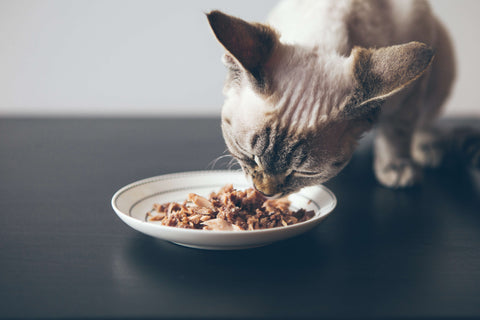Domestic Cats Evolved Out Of The Desert
Domestic cats evolved from Wild African Cats, which lived in the desert. Water wasn’t always freely available to them, leading them to develop a much higher tolerance for dehydration than humans. Instead of drinking water, they got the majority of their water from their prey, like mice.
Wet Food Keeps Cats Hydrated

In the average home, our cats aren’t going to be eating a steady diet of mice and other vermin. Instead, they have two options: wet food, or dry kibble. Unlike dry cat food, wet food has enough water in it to provide your cat with much of the hydration they need. You can then use a running source of water (like a pet fountain) to provide the rest of the hydration that they need.
Most dry foods contain a very low percentage of moisture and have a higher level of carbohydrates than wet food, which can lead to health issues like diabetes, and even liver or renal failure. The higher percentage of carbs and a lower percentage of water can also contribute to urinary tract infections and crystal build-up in the urethra.
Wet cat food is beneficial because it is closer to 70% moisture and typically contains fewer carbohydrates. Cats have no use for carbohydrates or grains in their diet. Their saliva and liver do not break down carbohydrates or grains to use for energy, so they pass through the system as waste.
Wet Food Gives Cats Essential Nutrients Like Taurine
Another benefit of wet cat food is the essential nutrients it provides. Taurine is an amino acid that cats need to survive, but their bodies do not produce it on their own. Taurine occurs in muscle meat and many organs such as the heart, liver, and kidney. A taurine deficiency can lead to all sorts of health problems for cats, such as blindness or tooth decay. Taurine is added to all cat foods in order to ensure that cats are getting enough.
But My Cat Doesn't Like Wet Food!
Cats are very texture based animals when it comes to eating. If they were only introduced to a certain type of food when they were younger, they might not see something like wet food as food at all. Whether your cat likes pate, shredded or minced meat with gravy, a soupy mixture, or something chunky, there is something out there for everyone!
Introducing wet food slowly is a good way to acclimate your cat to the change in their diet. Try placing some wet cat food on top of their dry food so they are prompted to eat it along with the rest of their meal. Cats eat with their noses first, and sometimes the stinkier the food is to our noses, the more appetizing it is to theirs.
Healthy Cats Are Happy Cats
One out of five cats in the United States is considered obese. One reason for this is the tendency we have to free-feed. We leave a full or mostly full bowl all the time, with the assumption that our cats will graze throughout the day.
While you increase the wet food you are feeding, be sure to decrease the amount of dry food available. You can even put that dry food in a kibble ball to make them work for their food.
While the initial cost of wet food is higher than feeding an all-dry diet, the overall health of your cat is improved tremendously by even a diet of partial wet food. Feeding an all-dry diet to a 10-pound cat costs about 50 cents per day (depending on the brand) while wet food can cost anywhere from $1.20 upwards. Usually larger cans cost less per ounce.
Some cats only like eating wet food when it’s fresh from the can, and won’t eat cold wet food that comes out of the fridge. In that case, try adding some warm water to the food and mixing it around. The higher cost may seem intimidating, but all of the health benefits might save you a trip to the vet in the future!
For more Info:
Why Cats Need Canned Food by Jean Hofve DVM November 18, 2010


